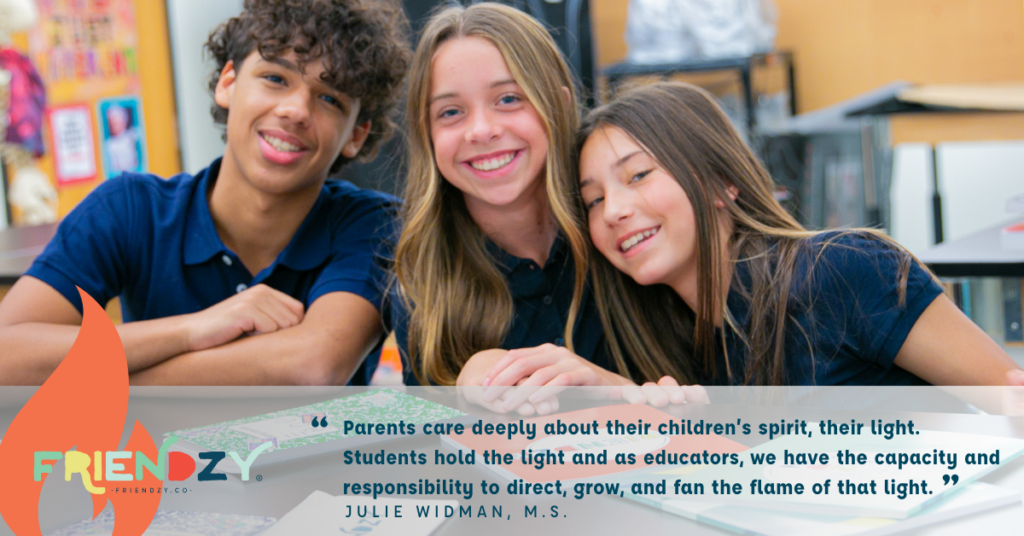Written by Julie Widman, M.S., co-founder of Friendzy, julie@friendzy.co
My daughter graduated from high school in June (whew!). One of the senior class’ most beloved English teachers was elected to address the attendees from the podium, celebrating the class of 2024. His message spoke to my heart as a parent and as an educator.
Mr. Jay reminded us of the important connection between students, schools and families. Drawing from his wisdom as a former college professor at Loyola, I see Matthew 5:16 in his message. He said, “…to teach a student is to teach to their spirit; to teach to the little light inside their hearts, and to take good care of that light. Graduates, throughout your schooling, when your parents would check in with you at the end of the day and look you in your eyes and ask, ‘How was school today?’ What they were really asking was, ‘How is that little light? Are you still letting it shine?’ Show how your light shines.”
Parents care deeply about their children’s spirit, their light. Students hold the light and as educators, we have the capacity and responsibility to direct, grow and fan the flame of that light. Family connection is vital and essential. The way schools care about children is reflected in the way schools care about children’s families.
A family’s engagement is continuous across a child’s life and entails an enduring commitment between the school and the family as children mature into young adulthood. My parental engagement has changed from the early years of reading groups and chaperoning field trips to later years of sports celebration committees and grad night prep.
Family engagement is not an easy process; in fact, research indicates there are barriers on both sides, including fear of conflict, distrust and excessive demands. All of these opportunities for tension threaten this vital connection between educators and families (Bang et al., 2021; Kelty & Wakabayashi, 2020). We live in such a divided world, and statements like, ‘If the family does their job, I’ll do mine’ or ‘I raised this child, now it’s your job to educate her’ are hurtful and lead to further disconnection (Constantino, 2021).
While there are separate spheres of influence at work in a student’s life, there is an undeniable overlap of influence between student, school and family. There is an opportunity in this connected influence. As Cook (2015) indicates, “Relationships have the potential to be a defining charism for 21st-century Catholic schools.” All of us care about the light, impact the light and grow that light.
More than 30 years of research has determined three truths about family engagement (Epstein et al., 2019):
- Families are not just passive observers in their students’ education; they are active participants who care deeply about their children’s success. They are eager to receive better information from schools, to be more than just good partners, but to also be integral contributors to their children’s education.
- Educators say they want to involve families, but many do not know how to build positive and productive programs and are fearful of trying.
- Students want their families to be knowledgeable partners and are willing to assist in communication between school and home actively. However, students need guidance and support on how to make this happen.
We all care about the light, and we can work together to help that light shine!
As we embark on the 2024-2025 school year, now is the time to revisit how we as educators care for our students and their families—Friendzy can help. Let’s fan the flame of our students’ light and care well for each little spirit that walks through our Catholic school doors.
Here are four easy steps including resources designed to help define and increase the opportunity for family connection at your school.
- Assess your school’s family engagement culture with these two self-assessments.
- Increase connection and engagement opportunities between educators, parents and students by providing easy-to-use connection resources designed for parents and caring adults.
- This professional learning opportunity provides insight into why connection matters with schools and families.
- Building Trust: there is no relationship without trust. Educators will find three interactive activities designed to foster trust.
References
Bang, Y.-S., Jang, H.-J., & Jung, J.-H. (2021). Understanding Korean early childhood teachers’ challenges in parent–teacher partnerships: Beyond individual matters. Social Behavior and Personality: An International Journal, 49(10), 1–16. https://doi.org/10.2224/sbp.10764
Constantino, S. M. (2021). Engage every family: Five simple principles. Corwin, A SAGE Publishing Company.
Cook, T. J. (2015). Charism and culture: Cultivating catholic identity in Catholic schools. National Catholic Educational Association.
Epstein, J. L., Sanders, M. G., Sheldon, S. B., Simon, B. S., Salinas, K. C., Jansorn, N. R., & Williams, K. J. (2019). School, family, and community partnerships: your handbook for action. Corwin, A SAGE Publishing Company.
Kelty, N. E., & Wakabayashi, T. (2020). Family engagement in schools: Parent, educator, and community perspectives. SAGE Open, 10(4), 1–13. https://doi.org/10.1177/2158244020973024

